CNC machining has revolutionized the manufacturing industry by providing high precision, repeatability, and cost-effective production solutions for a wide range of applications. Among the various processes involved in CNC machining, bead blasting is an essential one that greatly enhances the final product’s appearance and functionality. This article explores bead blasting as a crucial facet of CNC machining.
Bead blasting, simply put, is a surface treatment process where small round beads are projected onto the material at high velocities to clean or condition surfaces. In the realm of CNC machining, this method is used predominantly on metal parts to achieve desired finishing effects, but it can also be applied to other materials such as plastic and glass.
There are significant advantages to incorporating bead blasting into your CNC machining workflow. Primarily, it creates a smooth and uniform surface finish, which not only improves a part’s aesthetic appeal but also reduces friction, enhancing its mechanical function. Secondly, bead blasting eliminates burrs, defects, and contaminants from machined parts, resulting in cleaner products. Last but certainly not least, bead blasting increases the durability of components by stress-relieving their surfaces, making them more resistant to corrosion and wear.
To grasp how bead blasting works in CNC machining, we must delve into the process itself. A typical bead blasting machine comprises a blasting cabinet housing the workpiece, a media hopper containing the blast media (usually made up of glass, ceramic or steel beads), and a pressurised delivery system.
Initially, the CNC machined part is placed inside the blasting chamber. The operator then starts the blasting machine, which forces compressed air or water carrying beads through a nozzle towards the target component. As these tiny abrasive particles impact the surface, they effectively strip away any undesired layers, leaving behind a pristine, evenly-textured finish.
Certain factors like bead size, type, blasting pressure, and exposure time need careful consideration to achieve optimal results. Determining these parameters hinges largely on the application requirements. For instance, delicate parts or those with intricate geometries require smaller beads and lower pressures than bulkier, robust components.
Materials also play a crucial role in the bead blasting process. Steel shot is often favoured for heavy-duty applications due to its hard-wearing nature, while glass beads are preferred for achieving satin-like finishes without significantly altering the workpiece’s dimensions. Ceramic beads usually land somewhere in between, offering moderate abrasion and longevity.

Despite the overall simplicity of bead blasting, skilled operators must carry out this procedure in CNC machining to ensure excellent outcomes. They must understand how different materials react under varying conditions, possess an exemplary eye for detail to detect any defects, and maintain stringent safety protocols at all times.
In conclusion, bead blasting represents a critical component within the broader framework of CNC machining, enabling manufacturers to produce high-quality, intricately-finished parts that meet precise specifications. However, it demands expertise and requires careful manipulation of various parameters to yield the best possible results. Given its impact though, bead blasting remains an indispensable tool in modern manufacturing ventures. Whether you deal with automotive components, aerospace equipment, medical devices, or decorative pieces, bead blasting can take your CNC-machined creations from good to outstanding.
Other Articles You Might Enjoy
- Custom CNC Machining for Cutting-Edge Home Automation Systems
Introduction to Custom CNC Machining Custom Computer Numerical Control (CNC) machining is an advanced manufacturing process that uses pre-programmed computer software to guide machinery and tools in producing intricately detailed…
- Choosing Between 304 and 316 Stainless Steel for CNC Machining Applications
Introduction to 304 and 316 Stainless Steel in CNC Machining Applications The selection of the right grade of stainless steel is vital in Computer Numeric Control (CNC) machining applications. Here,…
- Exploring Bead Blasting in CNC Machining(tac welding Victoria)
CNC machining stands for Computer Numeric Control, which is a manufacturing process where pre-programmed computer software dictates the movement of factory tools and machinery. This method can be used to…









